How Long Does Cluster Feeding Last? Understanding the Phase
Understand the reasons behind frequent feedings and find effective and practical tips to manage this temporary phase with confidence
Published July 3, 2024

Navigating the world of newborn feeding can often feel like a rollercoaster for new parents—from understanding cues to mastering latching techniques, the learning curve is steep! Plus, adding a dose of stress to the mix—the phenomenon of cluster feeding, a period of intense and frequent feeding that can leave parents feeling both perplexed and exhausted.
Know that this is a common phase! And, we're here to shed light on the intricacies of cluster feeding, offering insights and guidance on how to weather this short but intense phase.
» Explore yummy plant-powered nutrition for healthy growth
What is Cluster Feeding?
Cluster feeding, as the name suggests, is when your baby seems to want to feed in clusters or frequent bouts rather than at their usual intervals. Instead of adhering to a predictable feeding schedule, your baby might suddenly want to nurse every hour or even more frequently, usually for several hours at a stretch. This behavior is often seen in the evenings but can occur at any time of the day.
» Discover expert-approved paced bottle-feeding techniques to conquer cluster feeding stress
Why is Your Baby Cluster Feeding?
There could be several reasons why your baby is displaying a heightened feeding pattern, such as:
- Growth spurts: Babies often undergo rapid growth during their initial months, and this can lead to an increased appetite. Cluster feeding can provide them with the additional nourishment they need during these crucial growth periods.
- Comforting mechanisms: For many infants, breastfeeding or bottle-feeding is not just about food but also comfort. During phases of developmental leaps, changes in routine, or minor ailments, they might seek additional comfort through more frequent feedings.
- Boosting milk supply: Cluster feeding can be nature's way of increasing milk supply in breastfeeding mothers. By feeding more frequently, the baby signals the mother's body to produce more breastmilk, thus ensuring adequate nutrition.
» Nourish your kid's body & mind with delicious, plant-powered goodness
9 Tips for Dealing with Cluster Feeding
Cluster feeding can be a challenging phase for new parents, but with the right strategies, you can make it more manageable and provide the best care for your baby. Here's how:
1. Stay Hydrated and Nourished
Taking care of a cluster-feeding baby requires stamina. Ensure you're drinking plenty of water, especially if you're breastfeeding, to maintain milk production. Keep snacks like nuts, fruits, and energy bars close by. A well-nourished parent is better equipped to handle the demands of a cluster-feeding baby.
» Find out why healthy eating matters in the first 1000 days
2. Make Yourself Comfortable
Extended feeding sessions can be tough on your body. Choose a comfortable chair with good back support. Using a nursing pillow can help maintain a comfortable position, reducing strain on your arms and back. Ensure the room has a relaxing ambiance, perhaps with soft lighting and soothing music. Invest in easy-to-wear, comfortable nursing clothes. This can make frequent feeding sessions less cumbersome and ensure you and your baby remain cozy throughout.
3. Nipple Care
Frequent feedings can cause sore or cracked nipples. To help with this, ensure your baby is latching on correctly. After feeding, you can apply some expressed breast milk to the nipple and let it air dry, as it has natural healing properties. Using a lanolin-based nipple cream can also provide relief and promote healing. If you're extremely sore, consider using a nipple shield temporarily, but do consult with a lactation consultant before use.
» Nurture your little one's development with organic plant-based nutrition
4. Breast Comfort
Engorgement can be a common issue during periods of cluster feeding. To ease discomfort, you can use warm compresses before feeding to help with milk flow and cold compresses afterward to reduce swelling. Wearing a supportive but not overly tight bra can also help. If you feel a lump or blocked duct, gentle massaging in a warm shower can provide relief. Should you experience continuous pain or suspect an infection, it's essential to consult with a healthcare provider or lactation consultant.
5. Take Turns
If you're bottle-feeding, it's beneficial to share the feeding responsibilities with another caregiver. This way, you can get the rest you need and approach each feeding session with renewed energy.
6. Practice Skin-to-Skin
Skin-to-skin contact isn't just for the hospital room. This close physical contact can comfort your baby during cluster feeding phases and help strengthen your bond.
» Deepen your bond and comfort your baby during cluster feeding by introducing plant-powered nutrition
7. Ask for Help
There's no shame in asking for assistance. Whether you need someone to do household chores, prepare meals, or simply offer emotional support, don't hesitate to lean on family or friends.
8. Set Boundaries
If you're feeling particularly drained, it's okay to set boundaries. Politely inform visitors that now might not be the best time for extended visits or that you're taking a break from hosting duties. Your primary focus should be on your baby and your well-being.
9. Stay Calm and Be Patient
Cluster feeding can be overwhelming, but maintaining a calm demeanor can help soothe your baby. Deep breathing exercises or meditative practices might help you stay centered during this intense phase.
» Find inner calm amidst cluster feeding with addition of plant-powered nutrition made from buckwheat, tapioca, and almonds
How Long Can Cluster Feeding Last?
The duration of cluster feeding varies for each baby, but in general, these intense periods can last for a few days to a week. Some babies might have multiple cluster feeding phases, especially during significant growth spurts, which typically occur during the first few days at home and around the baby's first few weeks of age.
While it's a demanding phase for parents, it's essential to remember that it's temporary. As the baby grows and settles into a more predictable routine, the frequency of cluster feedings usually diminishes. The answer, like many aspects of parenting, isn't always exact, but here's some clarity to offer respite to weary minds.
» Give your kid the plant-powered energy they need during cluster phase
- Newborn phase: Cluster feeding is most common in the first few weeks of a baby's life. This is the time when your baby is experiencing rapid growth and development. The constant demand for milk during this period helps in increasing the mother's milk supply to meet the baby's nutritional needs. For most infants, this phase lasts about 2-3 weeks, but some might continue this pattern for a month or more.
- Growth spurts: As your baby grows, it'll have several growth spurts. These can typically be seen around 3 weeks, 6 weeks, 3 months, and 6 months of age, though they can occur at any time. During these periods, you might notice a return of cluster feeding, which can last a few days to a week.
- Just seeking comfort: Sometimes, cluster feeding isn't exclusively about hunger. For some babies, the act of nursing offers comfort, especially during times of change, teething, or illness. In such scenarios, the duration of cluster feeding is less predictable as it's based on your baby's need for comfort rather than purely nutritional needs.
- Introduction to solids: As babies approach the 6-month mark and begin to integrate solid foods into their diet, their reliance on frequent breast or bottle feeds may diminish. This doesn't mean cluster feeding will stop abruptly, but the episodes might become less frequent and less intense.
» Find out when to start finger foods for babies
Remember, every baby is unique. While some might cluster feed for short periods, others might adopt the pattern for extended periods. Observing and understanding your baby's cues is crucial. Over time, most parents can discern patterns or identify specific triggers that prompt these feeding marathons.
Navigating Feeding Patterns
Cluster feeding, while challenging, is a natural and short-lived phase in a baby's early life. It's a testament to babies' incredible adaptability and innate ability to communicate their needs. By understanding the reasons behind cluster feeding and equipping themselves with coping strategies, parents can better navigate this demanding yet fleeting stage.
» Nourish your kiddo during cluster feeding with organic plant-powered, growth-boosting nutrition
FAQs
Is cluster feeding a sign of low milk supply?
No, cluster feeding is not necessarily a sign of low milk supply. It's often just a baby's way of signaling the body to produce more milk or seeking comfort.
Can formula-fed babies cluster feed?
Yes, formula-fed babies can also exhibit cluster feeding behaviors, especially during growth spurts or times of increased comfort-seeking.
How can I tell if it's cluster feeding or colic?
While both can lead to increased crying, cluster feeding typically involves frequent feeding requests, while colic may involve long periods of crying without a clear cause.
Does cluster feeding lead to overfeeding?
It's challenging to overfeed a breastfed baby since they'll typically stop nursing once they're full. If bottle-feeding, be attentive to cues to ensure the baby isn't being overfed.
Should I wake my baby to feed during cluster feeding phases?
It's best to feed on demand during cluster feeding phases. If the baby is sleeping peacefully, there's no need to wake them for a feed. However, always consult your pediatrician for personalized guidance.
Does cluster feeding mean my baby isn't getting enough milk during regular feedings?
Not necessarily. Cluster feeding is a natural behavior observed in many infants, especially during growth spurts. It's their way of ensuring they get enough nutrients and also helps in boosting the mother's milk supply. If your baby is producing enough wet diapers, gaining weight appropriately, and seems content between these cluster feed sessions, it's likely they're getting the nourishment they need.
The content and advice provided in this article are for informational purposes only and are not a substitute for medical diagnosis, treatment, or advice for specific medical conditions. Always consult a pediatrician to understand the individual needs of your child.












